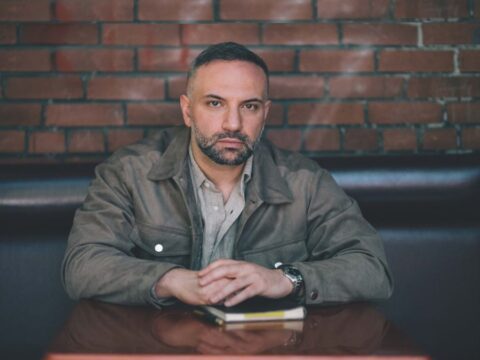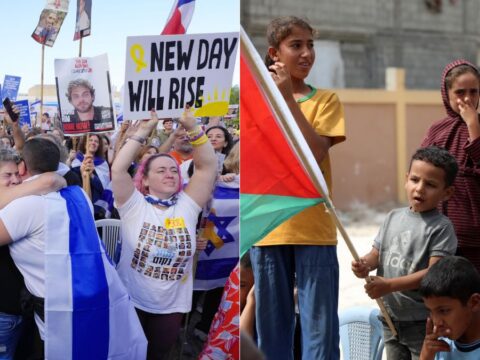The immigration officer gave Halima* and her husband, Ahmed, an impossible choice.
“He said since the kids are Canadian citizens, they can stay. But both of you, you have to go,” says Halima, incredulous. “How could I do that? How could I leave my kids here? It doesn’t make sense! But he told me, ‘That’s the law.’”
You may unsubscribe from any of our newsletters at any time.
The couple had arrived in Montreal in 2004 as refugees seeking asylum from a revolution that turned their Middle Eastern country “upside down,” as Halima describes it.
Despite the hardships of leaving home and integrating into a new culture, the couple moved into a nice apartment, made friends, studied French, got work permits, found jobs and had two sons. They also went through the onerous process of applying for refugee status. Three years later, a judge denied their claim.
The couple then applied for permanent residency based on humanitarian and compassionate grounds. (Before they left their home country, they had received threats that they would be physically harmed.) Several years later, they were again refused. Before they could try once more, they received deportation orders in 2014.
Presented with the option of leaving their Canadian-born children behind, Halima boldly asked the officer, “If they were your kids, would you leave them?”
“No,” he replied. “I wouldn’t do that.”
Neither could Halima. So Ahmed returned alone, and Halima stayed behind with their children. Without status, she went into hiding, petrified she could be separated from her sons or forced to take them to her former country, where they had no future.
No one knows exactly how many people live in Canada without status. Estimates suggest 200,000 to 500,000 irregular, undocumented or “illegalized” migrants are trying to avoid detention or deportation. Many stay in Canada after their visa expires, others lose their status and some, like Halima, disobey orders to leave.
Undocumented people are isolated, afraid and vulnerable as they try to eke out a living undetected and completely outside the system. In response, a handful of Canadian municipalities have declared themselves “sanctuary cities” to help these people live without fear of being reported to immigration officials. While this is a good start, advocates are concerned gaps in the system keep those without status unprotected and in the shadows.
The concept of sanctuary cities is ancient, dating back thousands of years, with references found in the Old Testament. But it’s quite new in Canada.
In 2013, Toronto became the country’s first official sanctuary city. This means no one is supposed to be asked what their status is when they use municipal services.
In 2013, Toronto became the country’s first official sanctuary city after years of advocacy by groups who eventually joined forces under the umbrella name Solidarity City Network. This means no one is supposed to be asked what their status is when they use municipal services such as getting on a bus, signing up for a library card, taking English classes or joining a recreation centre. And if city staffers discover someone doesn’t have status, they are not supposed to report it to authorities.
In the past four years, Montreal and the Ontario cities of London and Hamilton have joined the sanctuary movement. Last year, Vancouver city council instead chose to adopt the policy Access to City Services Without Fear for Residents with Uncertain or No Immigration Status, which initially excluded key services such as parks and libraries.
“Yes, there’s something about compassion in politics, which I believe in, but it’s also just about being smart,” says Toronto Councillor Joe Mihevc, a longtime cheerleader for the city’s sanctuary policy, called Access T.O. “What good does it do to go after these people? You’re not going to achieve a healthy city atmosphere and civic well-being. . . . You’re going to create a climate of fear.”
Canadians only need to look south of the border to see how fear among newcomers plays out. U.S. President Donald Trump’s hardened stance on immigration has caused hundreds of asylum seekers to cross the Canadian border on foot via ditches and fields, even in the dead of winter.
The Canada-U.S. Safe Third Country Agreement requires would-be refugees to make a claim in the first safe country in which they arrive. They can’t arrive in the United States, for example, and then try to claim asylum at Canadian airports or official border crossings.
Fearful of deportation amid a toughened political environment, an increasing number of migrants are finding ways to slip into Canada. In response, more Canadian municipalities are having discussions about declaring sanctuary status, including Ottawa, Regina, Saskatoon and Winnipeg.
“We have this mass movement of people over borders, about [11] million people [in the United States] who are undocumented, and despite Trump’s best efforts, they ain’t going away. It’s just not gonna happen,” observes Mihevc. “Same thing here in Canada. They’re here, we’re here, so we have to find a way to live together, and as a city . . . our job is to protect and enhance the lives of residents of Toronto, residents being the key word.”
Not everyone agrees with Mihevc. Some consider non-status migrants “queue jumpers,” people unfairly taking advantage of the system, or even criminals. They don’t see any reason to help those breaking the rules. According to a Reuters/Ipsos poll conducted in March, 48 percent of Canadians say they support “increasing the deportation of people living in Canada illegally.”
Advocates like Navjeet Sidhu aren’t surprised by these opinions. He is the author of the 2013 Social Planning Toronto report on the accessibility of community services for non-status immigrants. Sidhu was among those who worked hard to convince Toronto to become a sanctuary city, and he has heard all the criticisms.
“There’s that misconception that there’s a line and you just wait your turn, which really doesn’t exist,” Sidhu explains. “It’s often very difficult for people to navigate an immigration system that seems to be constantly changing.”
He points out that when Stephen Harper was prime minister, the federal government started focusing on allowing “highly skilled” workers, such as software developers, engineers and doctors, to immigrate to Canada. Those with “low” skills, such as farm labourers and caregivers, can often only stay for short periods as temporary workers.
“I think that’s problematic, because people can contribute to the economy in all sorts of ways,” says Sidhu. “There’s no reason that somebody can’t develop their skills while they’re here, like my parents did when they came and went to school at night and got a better job. Those policies have unfortunately changed.”
If temporary migrant workers decide they’d like to remain in Canada, they sometimes live without status as they go through the maze-like immigration process — not because they’re trying to circumvent the system, but because they’re trying to go through it.
Living outside Canada’s system is no easy task. Without status, people aren’t legally allowed to work, they can’t collect social assistance and they can’t get a credit card or mobile phone plan. Finding housing is almost impossible, and health care is extremely expensive and risky. (Some hospitals call the Canada Border Services Agency if they discover a patient doesn’t have status.)
Lucia* knows what it’s like to endure exploitation and feel powerless to do anything about it. She arrived in Toronto from Mexico about 15 years ago on a four-month visitor’s visa and quickly landed under-the-table work at a restaurant.
Her boss took advantage of her precarious situation, paying her below minimum wage — $5 an hour. After eight years, he finally gave her a $1 raise. He sometimes made her work double shifts from 8 a.m. until 3 the next morning, only allowing Lucia a couple of hours of sleep before starting all over again.
Lucia didn’t complain. She couldn’t risk being fired. After all, who else would hire someone without documents? She had no idea where to turn for help or even that Toronto had become a sanctuary city.
“It is very lonely,” says Lucia. “You have no idea how many times I cried by myself.”
Since then, she met and has married a Canadian man, obtained her permanent residency and was finally able to leave the restaurant job.
For her part, Halima remembers how hard it was when her husband was deported: “You can’t have any revenue . . . so you have to work very hard. . . . You have no rights. You have to accept any job. You have to accept any salary.”
She managed to scrape by on some money from her brother-in-law, who lives in Canada, and by working as a cleaner and a cook. Afraid to be in their apartment where immigration officials knew they lived, Halima and her boys stayed with different friends, constantly on the move.
‘I was scared all the time, depressed all the time. You’re hiding like a criminal, like someone who did a big crime, which I’m not.’
“I was scared all the time, depressed all the time. Suddenly I’m alone with two kids in that situation, and it was a nightmare. . . . I didn’t want to see anybody or speak to anybody,” she says. “You’re hiding like a criminal, like someone who did a big crime, which I’m not.”
Montreal declared itself a sanctuary city in February, but Halima is skeptical. “Honestly, I read a lot of stories about Toronto, that it was a sanctuary, but under which meaning? How? By name? Or is it real?”
Advocates for sanctuary acknowledge the wariness among the very people they want to help, which poses just one of many challenges.
Idil Atak is a co-researcher of “(No) Access T.O.: A Pilot Study on Sanctuary City Policy in Toronto, Canada,” which was funded by the Ryerson Centre for Immigration and Settlement, and evaluated Toronto’s competence at implementing its sanctuary city policy. Atak says city staff is doing a wonderful job.
“The message the city sends is that we acknowledge that this population exists, first of all, and they are victimized, they are marginalized. They are not criminals,” she says.
However, she and her team identified some growing pains. For one, the program needs to raise awareness that it exists. “If the undocumented migrants don’t really know their rights, they don’t know that they can access employment help or public health services or rec programs,” explains Atak.
Staff members also need more training to ensure everyone is on the same page with Toronto’s “don’t ask, don’t tell” policy. A telephone audit of 185 city service providers, conducted in 2013 by the Solidarity City Network, found that there was misunderstanding or lack of awareness among city staff about the policy. Twenty-five percent either said undocumented residents couldn’t receive a service or didn’t know if they could. An audit conducted in 2015 by the FCJ Refugee Centre also found inconsistent knowledge.
More work needs to be done between government levels as well. Some city programs related to accessing employment, health care or housing also receive provincial or federal funding. This puts the whole “don’t ask, don’t tell” concept in a grey zone, as neither of these levels of government has declared sanctuary.
Atak says her primary concern, though, is co-operation by the Toronto Police Service, whose board put a “don’t ask” policy in place in 2006. Since then, police officers have been trained not to inquire about people’s immigration status. However, if they learn someone is here without status, they believe they are legally obligated to divulge that information to border services.
According to a 2015 report by the advocacy group No One Is Illegal, the Toronto police are the most frequent users of the Canada Border Services Agency’s call centre for law enforcement — and 83 percent of the calls are status checks.
“It’s very contrary to the objective and the very spirit of the [sanctuary] policy,” says Atak of police actions. “Because the idea was that we need the policy in order to ensure that undocumented migrants feel safe to call the police when they witness a crime or when they are victimized themselves.”
Toronto Police Service is unapologetic about its stance, but agrees completely with Atak that everyone in the city, especially those on the margins, needs to feel they can go to the police.
“Witnesses are hugely important to us, so we have every incentive to do what we can within the rules that are set for us to ensure that victims and witnesses are not in positions where they are exploited,” says police spokesperson Mark Pugash. “We need these people to come forward. If they don’t feel that they can come forward, it not only means that they are ripe for continued exploitation, but it means that the people who are exploiting them are then free to exploit other people, which is something we are very aware of.”
Rather than everyone pointing fingers at the police, whose hands are legally tied, Pugash says he would like to see more constructive discussions on how to better help those who are vulnerable.
Until federal, provincial and municipal governments figure out how to best protect people like Lucia and Halima, non-profit groups are stepping in to fill the gap.
In Vancouver, Natalie Drolet is a lawyer and the executive director of the West Coast Domestic Workers’ Association. She and her team provide free legal advice to temporary foreign workers who are in abusive situations but have nowhere to turn. They also act as a bridge with the Vancouver Police Department.
Drolet says people without status who haven’t connected with an organization like hers, which has built trust with the Vancouver police, are generally at great risk if they come forward to report any kind of crime, including domestic abuse or exploitation by an employer. “If they think that their immigration status will be at risk by contacting the police, they will likely hesitate to do that,” she says.
Meanwhile, in Montreal, with the help of Canadian friends and advocacy organizations, Halima applied for permanent residency a second time and was finally granted it in 2017. Now she is working to bring Ahmed back to Canada by preparing a sponsorship application, which includes heart-wrenching letters from their sons.
“Each one, he starts to write his letter saying, ‘Please, I need my daddy to get back here,’” says Halima.
In her 13 years of marriage, this is the longest she and her husband have been separated. She makes sure her boys talk to Ahmed regularly, but she sees the toll it is taking. Now 11 and nine years old, they better understand the complexities of immigration.
“Yesterday was an awful day,” says Halima. “My kids keep crying about how their friends all live with their father, but they don’t. I told them it’s okay, we’re preparing the papers now, and everything will be okay. I tell them it will be fine, but . . .”
Her voice trails off, knowing nothing is guaranteed.
“We need to live in peace, that’s all,” she says resolutely. “I’m not looking for a fun or luxurious life; just peace for me and my kids.”
*Names and identifying facts have been changed to conceal the identities of Halima, Ahmed and Lucia.
This story originally appeared in The Observer’s June 2017 issue with the title “Undocumented.”
















If you are advocating no immigration policy and open borders because this is what it sounds like, you only need to see what is happening along the US- Mexico border right now under the Biden Administration. What is happening there today is not compassion at all. You like to use the word compassion alot to shame those of us who want a workable immigration system and not what you are essentially calling for which is open borders.